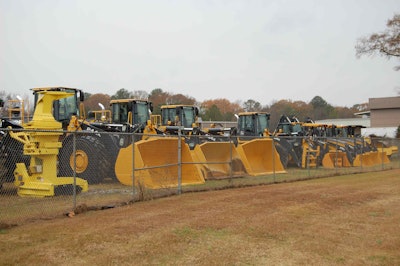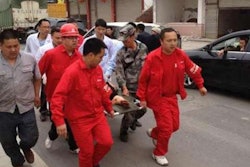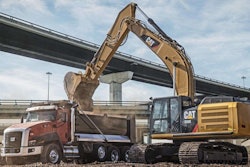
Construction activity has started to pick up but is in a slow climb. In this atmosphere, is it better to rent, purchase or lease? That depends on a variety of factors, according to Peter D. Gregory, senior vice president of the Construction Group of Wells Fargo Equipment Finance in Atlanta.
“What you are seeing now in the market is a lot of uncertainty, so customers have been hesitant to purchase equipment or get into long-term leases,” Gregory says. “They don’t know what is coming down the road, and backlogs are not what they used to be.”
Yet firms still require heavy equipment to get the job done. Some larger companies allow equipment managers, in collaboration with the chief financial officer, to opt for buying, renting or leasing, while at smaller firms, the owner generally makes that decision.
“There is no right or wrong, just different situations for different companies,” Gregory says. “You have to look at your tax situation, your financial statements and the effect leasing, buying or renting will have on each.”
Determining what’s best requires some foresight and predictions about what the future will bring, which remains a challenge.
“Sometimes you are making an educated guess with the information you have,” he adds. “But you still have to do the full analysis.”
Rent
Contractors can conserve capital with a rental.
“You are not on the hook,” Gregory says. “You can try and buy. If you like it, you can keep using it.”
Additionally, the dealer maintains the unit, so the contractor avoids the expense of upkeep. If a piece of machinery breaks down, the dealer will fix it, and if the repair will take an extended amount of time, the dealer will usually exchange the broken unit with a different one.
Dealers have increased their fleets recently, buying more units from manufacturers to meet the demand for rentals.
“We’ve seen rental fleets for dealers grow tremendously in the last couple of years,” Gregory adds.
Contractors often will rent when they need a specific item for a particular job, especially in times of uncertainty to avoid taking on more expense if lacking a stable backlog. In turn, the contractor may add that cost to the job pricing.
“Renting may make sense, so you are not taking on that additional expense,” he says. “Renting is a little more expensive, because there is more flexibility. You are not committed to anything.”
For customers aiming to learn more about a piece of equipment and to try it out before investing, dealers often will offer a rental-purchase option. Those, typically, last about six months, and the rental payment can be applied to a down payment if the contractor then decides to finance it.
“Renting presents little risk,” Gregory says. “It offers a lot of flexibility.”
Purchase
Buying equipment offers immediate ownership, and deductions for depreciation and interest can bring down a firm’s taxable income and save the company on its taxes.
“Customers will build equity in their companies through their equipment, as values have consistently gone up, except during the 2008-2009 period when some of that changed,” Gregory says.
Most often, a company will finance the purchase of a piece of equipment. The equipment is added to the balance sheet as an asset, and the debt is noted as a liability. The depreciation and interest are used as deductions to income on their income statement.
The Tax Relief, Unemployment Insurance Reauthorization and Job Creation Act of 2010 created bonus depreciation in Section 179 of the Internal Revenue Code, with more of the depreciation taken in year one. That benefited some companies and prompted more sales in recent years and has been extended by the American Taxpayer Relief Act of 2012 through 2013.
On the other hand, businesses subject to the Alternative Minimum Tax (AMT) have a huge reason to lease, since depreciation is a preference item subject to an AMT penalty.
Lease
Companies that are not profitable may not be able to efficiently use the depreciation; therefore, for them leasing make may more sense than buying, Gregory says.
Leasing offers a usage arrangement rather than ownership, and it typically requires no cash upfront. Leases usually last from three to five years.
“You are putting the risk of obsolescence onto the lessor,” Gregory says.
That certainly comes into play as electronics and computer technology increasingly are built into the equipment, such as GPS systems on pavers and graders that save on labor costs.
“There is a lot more technology in the equipment than in the past,” Gregory says. “Technology is more of an issue than years ago.”
Lease payments are lower throughout the term than the cost of principal and interest, because of a balloon or purchase option at the end. The price might be set at the beginning of the agreement, or the deal could include a fair-market payment at the end.
“The customer can use the equipment and walk away at the end of the term and have some cost savings in the form of lower payments.”
Additionally, sales tax is added to each payment not paid as a lump sum at the front as occurs with a purchase.
Larger contractors may lease for specific jobs and match project costs to the equipment lease, he adds.
Companies can write off each lease payment as an expense on their taxes. The lessor keeps the depreciation and passes on that benefit to the lessee in the form of a lower lease payment.
Additionally, leases typically are structured as an off balance sheet product, with the lease payments taken off as an expense of doing business.
“There is some benefit for them on their financial ratios, namely their debt to worth and current ratios,” Gregory says. “A lot of contractors do bonded work, and having those units off balance sheet can help improve their ratios, which their bonding, pricing and capacity is based on.”
Leasing can produce a higher overall cost for the equipment than an original purchase, and the lessee must continue its obligation to pay throughout the lease term. If the company stops needing or using the equipment, there is usually a cost involved with terminating the lease early.
Selecting a leasing agent
If a company decides on leasing, it behooves the firm to research the potential lessor, looking for a company that routinely writes leases for construction equipment and will know what the equipment and values will do over a several-year period. Equipment dealers and manufacturers know what leasing companies regularly work in the construction field. In addition, the contractors’ bank may also offer leasing.
“Lessees want someone who knows the dealer, knows the industry and will be around,” Gregory says. “When you have someone who just dabbles in construction, they won’t know all the factors you deal with on a day-to-day basis. When you deal with someone in the construction industry, they will know things you are facing, and they can help you structure a better product.”
For instance, the number of hours the equipment is used annually will be less in areas of the country where weather keeps jobs on a three-month hiatus than in other regions, such as Florida, where construction takes place year round. Therefore, the lease can be structured accordingly, since the value of the unit will be higher at the end of the lease period due to the fewer hours of use.
Some contractors use equipment harder than others, such as moving rocks all the time versus sand, and that can affect the value at the end of the term. The lessor should know that, so it can structure the agreement accordingly.
“The lessor is taking a risk, and you need to know how your equipment is being used in order to be able to manage that risk,” Gregory says.
Confounding factors looking forward
The off-balance sheet advantage afforded by leases is under review by the International Accounting Standards Board and the Financial Accounting Standards Board. The two organizations aim to develop a common method globally for reporting leasing transactions on financial statements. The organizations will likely issue the new rules in 2014 and transition to the new standards in 2017.
Proposed changes include the lessee recording an obligation to make leased equipment a right-of-use asset, with all leases appearing on the balance sheet. But leases of less than a year will likely not be added back on the balance sheet. Purchase options will generally be considered a liability. Gregory cautions that the changes may be retrospectively applied to existing leases.
“That will have a big impact on the industry,” Gregory says.
For now though, Gregory remains bullish about leasing.
“Leasing gives you a lot of flexibility and benefits,” he concludes. “But you need to look at all three – renting, leasing and buying – when you are making a decision to acquire equipment and see what will work out best for you.”














